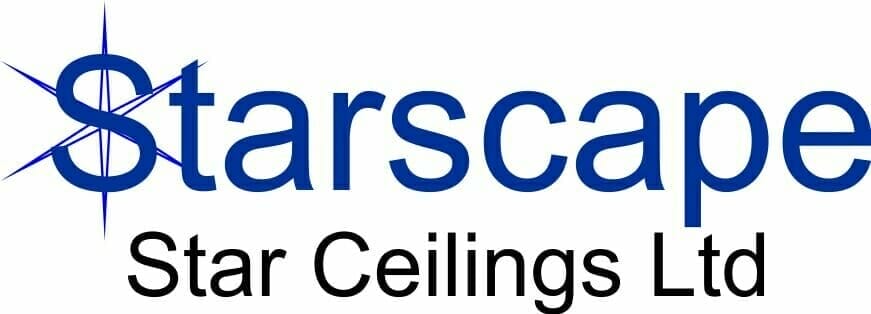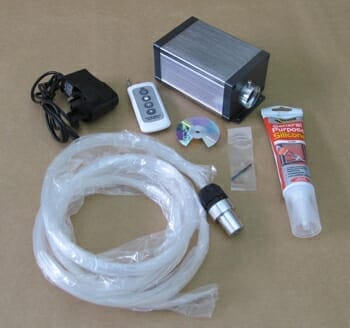
A fibre optic star kit has just two main components. A light source, and a harness of optical fibres, usually at various lengths and diameters.
A fibre optic light source (sometimes called a light engine or projector) is essentially a box with a lamp of some sort in it – these days most commonly an LED (light emitting diode) or cluster of LEDs. The move in the past few years towards using LEDs in place of halogen bulbs or metal halide bulbs means that light sources use less power, generate less heat and require less maintenance. There’s no bulb to ever change and LEDs should last in excess of 40,000 hours – long enough to see a new baby through to university.
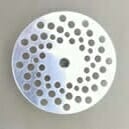
Inside most light sources there’s a motor or motors which turn effects wheels to modify the light before it enters the optical fibres. A twinkle wheel has a number of holes in the Aluminium disk that alternately interrupt and then allow the light to pass to the fibres.
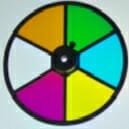
Fibre optic light source twinkle wheelFibre optic light source colour wheelThis produces a twinkle at the far end of the fibre. A colour wheel is a disk of different coloured dichroic glass filter elements arranged as “pie segments” and as this rotates in the beam of light the colour in the fibres changes. Some light sources these days use different coloured LEDs to mix colours and so don’t require a colour wheel. Our MaxiLEDRGBW light source features this technology and so can show a far greater range of different colours. A colour wheel always has a clear section to allow it to show plain white light. Where a light source has both a colour wheel and a twinkle wheel it can show both twinkle and colour effects simultaneously, whereas in more simple models you fit the wheel of your choice to produce either twinkle or colour.
Light source control options can range from simple on/off and dimming by remote control to much more sophisticated mechanisms to allow integration with home automation systems such as Rako, Lutron and Control4.
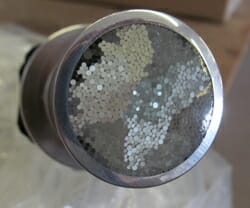
If you look at the different models on our light sources page you’ll see that they come in all shapes and sizes. The one thing they all have in common is an opening or “optical port” at the front. This is where the optical fibres plug in so as to be illuminated by the LED.Photo showing the tightly packed 0.75 and 1.00 fibres in a common end ferrule from a MaxiLED40 light source. The fibres are combined in a “harness” in which all fibres come together in a “common end” which plugs into the optical port. The common end consists of an aluminium ferrule and a cable gland that between them secure the bundled fibres and align their ends neatly. When the common end is slid into the light source, the collar of the optical port holds the ferrule at 90 degrees to the LED to allow the maximum light to enter the fibre.
A harness can theoretically have just a single fibre or more than 1000, depending on the application, the size of the light source and the diameter (thickness) of the fibres. Fibres of different diameters are typically mixed in a harness to create a 3-dimensional – or “near and far” – effect in a star ceiling and in most cases the fibres in a harness will be cut at a range of different lengths.
There’s no electricity or heat in the fibres – they simply carry light in the same way that a hose carries water. Cut the end off a fibre and the light will shine brightly from the new end. If your light source stops working or if you want to upgrade to a better light source with more features you simply slide the common end out of the old light source and plug it into the optical port of the new light source.
We offer a range of ready-made harnesses for the DIY customer, but we also make up bespoke harnesses every day to suit the specific needs of customers where the off-the-shelf harnesses aren’t the best fit.

Micro lens end fitting
If you are thinking about end fittings for your star ceiling follow this link. However we don’t recommend using them for star ceilings.
